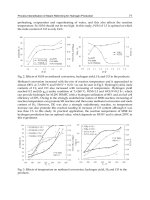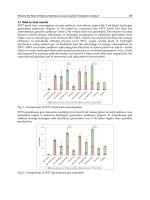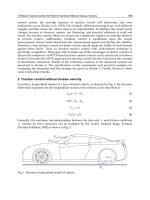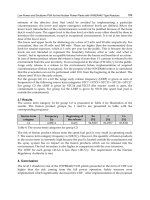Automation and Robotics Part 5 pdf
Bạn đang xem bản rút gọn của tài liệu. Xem và tải ngay bản đầy đủ của tài liệu tại đây (1.66 MB, 25 trang )
Automation and Robotics
94
5. Simulations
As the object of simulations we have chosen a model of the inverted pendulum on two fixed
wheels presented in Fig. 1. The goal of simulations is to examine the behaviour of the
presented control algorithm using a full knowledge about the dynamics. The motion of the
closed loop system has been examined by simulations which have run with the MATLAB
package and the SIMULINK toolbox.
•
First, the desired trajectory for inverted pendulum was chosen as a constant
configuration
3/
π
α
=
d
. The start position of the platform was equal to
()
(
)
0,0,0)0(),0(),0(
=
θ
yx and start position of the manipulator
(
)
00
=
α
. In Fig. 2b
tracking terror
1
η
e
for the mobile platform have been shown. The relationship between
reference velocities is selected as
rr 21
ηη
= (straightforward motion). Figure 2a presents
tracking error
α
e for the inverted pendulum. The gains of control parameters used for
getting plots presented in Figure 2 are equal to
50
=
m
K , 100
=
p
K , 50
=
d
K .
a)
b)
Fig. 2. Tracking errors occurring in the balancing robot during tracking constant
configuration: a)
α
e b)
1
η
e
• Next, the desired trajectory for inverted pendulum was chosen as a slowly changing
periodic function
(
)
(
)
10/sin05.0 tt
d
=
α
. The start position of the platform was equal to
()
(
)
0,0,0)0(),0(),0( =
θ
yx and start position of the manipulator
(
)
00
=
α
. In Fig. 3b
tracking error
1
η
e for the mobile platform has been shown. The relationship between
reference velocities is selected as
rr 21
η
η
=
. Figure 3a presents tracking error
α
e for the
inverted pendulum. The gains of control parameters used for getting plots presented in
Fig. 3 are equal to
50=
m
K ,
100
=
p
K
, 50=
d
K .
Nonlinear Control Law for Nonholonomic Balancing Robot
95
a)
b)
Fig. 3. Tracking errors occurring in the balancing robot during tracking periodic trajectory:
a)
α
e b)
1
η
e
6. Concluding remarks
In the paper a new control algorithm for nonholonomic balancing robot (inverted pendulum
mounted on a two fixed conventional wheels) has been introduced. The algorithm covers
not only stabilization of the pendulum about a desired constant configuration
d
α
, not
necessary 0, but the tracking of some time-dependent trajectory as well. Differently from
previous works presenting control problem of the balancing robot, the motion of the robot is
not restricted to straight-line motion but it is possible to realize more complicated
manoeuvres on XY plane without slipping of robot's wheels. It depends on the selection of
relationship between reference velocities designed for the wheels, what case of robot's
motion will be realized in practice.
In our forthcoming research we will focus on extending the presented approach to other
cases of mobile manipulators
(
)
hnh, with different structures of passive joints.
8. References
C. Canudas de Wit & B. Siciliano & G. Bastin. Theory of Robot Control, Springer-Verlag,
London, 1996.
A. De Luca & S. Iannitti & G. Oriolo. Stabilization of the PR planar underactuated robot.
Proc. IEEE International Conference on Robotics and Automation (ICRA 2001), pp.
2090−2095, 2001.
M. Krstić & I. Kanellakopoulos & P. Kokotović,
Nonlinear and Adaptive Control Design, J.
Wiley and Sons, New York, 1995.
A. Ratajczak & K. Tchoń. Control of underactuated robotic manipulators: an endogenous
configuration space approach. Proc. IEEE Conf. on Methods and Models in
Automation and Robotics MMAR 2007, pp. 985−990, Szczecin, 2007.
Automation and Robotics
96
Rich Chi Ooi, Balancing a Two-wheeled Autonomus Robot, The University of Western Australia;
Final Year Thesis, 2003.
Segbot - Final project for the Introduction to Mechatronics class at the University of Illinois
2004.
6
Deghosting Methods for Track-Before-Detect
Multitarget Multisensor Algorithms
Przemyslaw Mazurek
Szczecin University of Technology
Poland
1. Introduction
Track-Before-Detect (TBD) algorithms are very powerful for tracking applications. In
comparison to classical (Detect-Before-Track) algorithms they are computationally
demanding but allow achieving incredible SNR (Signal-to-Noise Ratio) performance. For
classical systems SNR should be greater then one. If this condition is fulfilled classical
tracking algorithms does not need a lot of computations and they process acquired data by
filtering, detection and estimation algorithms. Typical detection algorithms based on fixed
or adaptive threshold fails for SNR<1 because if signal is below noise floor a lot of false
measurements occurs or target can not be detected correctly. Improving performance for
low SNR systems is very important from applications point of view and it is research very
active area using alternative approaches and improved algorithms.
Track-Before-Detect algorithms are excellent alternative for low SNR signals because signal
(target) detection is processed after intensive testing set of hypotheses related to possible
signal states (e.g. object trajectories). Even if there are no any signal from target complete
search is used for best performance. Huge discrete state-space needs a lot of computations
mostly not related to real state of target. Today available computing devices like fast
processors, specialized VLSI circuits and distributed computing methods allows gives a
possibility of using real-time TBD algorithms for dim target tracking. It is worth to be noted
that computation cost for TBD algorithms is serious disadvantage because it significantly
influent on financial cost of system but it can be meaningful for military applications (air,
naval or space surveillance) where plane, ship or political costs are much more significant.
There are two groups of TBD algorithms. The first one group contains deterministic TBD
algorithms statistical computations oriented for results calculation. All hypotheses are tested
and computation cost is usually constant. The second one group contains nondeterministic
TBD algorithms. Such algorithms do not test all hypotheses only use statistical methods for
finding most probable results but optimality of results is not guarantied. For example
particle filters are statistical search based and they gives results sometimes faster in
comparison to first group of algorithms (Gordon et al., 1993; Doucet et al., 2001;
Arulampalam et al., 2002; Ristic et al., 2004), but deterministic group is much more reliable
for many application and is only considered in this chapter. For real-time applications first
group has advantages of results quality and constant processing time - very important for
Automation and Robotics
98
every system developer. It is worth to be noted that useful TBD algorithms for practically
applications are not optimal. There is optimality in some sense for particular algorithms but
only bath processing is optimal from detection quality point-of-view. Bath algorithm tests
all hypotheses (all object trajectories) using all information from beginning up to actual time
moment (Blackman & Popoli, 1999). Unfortunately bath processing is not feasible for real-
time applications because memory and computation cost is growing. Much more popular
are recurrent TBD algorithms and last results and actual measurements are used for
computations (like 1’st order IIR filter). There are also popular algorithms based on FIR
filters and they use N-time moments for computation results.
Independently on computation cost of TBD there are other limitations that are challenges for
developers. Classical and TBD algorithms are quite simple for single object tracking but
more complex approach is necessary if there are multiple targets or false target due to
measurement errors. A false measurement occurs due to occasional high noise peaks that
are detected as targets. Assignment, targets track live control, targets separation algorithms
and multiple sensors are considered for multiple target tracking. Excellent books (Blackman,
1986; Bar-Shalom & Fortmann, 1988; Bar-Shalom ed. 1990; Bar-Shalom ed. 1992; Bar-Shalom
& Li, 1993; Bar-Shalom & Li, 1995; Brookner, 1998; Blackman & Popoli, 1999; Bar-Shalom &
Blair eds. 2000) includes thousand references to much more specific topic related papers are
available but there is a lot of to discover, measure and investigate.
Most multiple target tracking algorithms are related to classical systems but there are also
well fitted algorithms for improving TBD trackers. Simple method is using TBD algorithm
results as input for high level data fusion algorithm that should be tolerant for redundant
information from TBD algorithms. Very important part of TBD is state-space that should be
adequate for application and decide about algorithm properties significantly. In this chapter
is assumed strength correspondence of state-space to the measurement space. It allows
simplify description of behaviours of TBD algorithms using kinematics properties. The
measurement space depends on sensor type. From Bayesian point of view different sensors
outputs can be mixed for calculation joint measurements. This data fusion approach is very
important because there are sensors superior for angular (bearing) performance like optical
based and sensors superior for distance measurements like radar based. Diversification of
sensors for measurement for tracking systems improvements is contemporary active
research area. Progress in optical sensors development for visible and infrared spectrum
gives passive measurements ability that is especially important for military applications and
linear and two-dimensional optical sensors (cameras) are used. Unfortunately distance
measurement using single sensor without additional information about target state is not
possible. Another disadvantages of optical sensors is an atmospheric condition so dust,
clouds, atmospheric refraction can limits measurement and tracking abilities for particular
applications. Because targets move between sensors and background (for example moving
clouds) background estimation is a very important for improving SNR. Another problem is
optical occlusion that limits tracking possibilities (for example aircraft tracking between or
above clouds layer). Such limitations related to optical measurement sensors are related to
single and multiple targets tracking also, but there is another non-trivial multiple target
related problem known as a ghosting (Pattipati et al, 1992). For every bearing only system
ghosting should be considered and suppression methods should be used or obtained
tracking results are false.
Deghosting Methods for Track-Before-Detect Multitarget Multisensor Algorithms
99
2. Ghosting and basic methods of ghost suppression
2.1 Ghosting
In this chapter are considered sources of ghosts and methods for suppression them using
illustrative examples for usually hard to visualize high dimensionality state spaces. For
single or multiple targets positions estimation two or more sensors are necessary. Using LOS
(Line-of-Sight) triangulation target position and distance estimation is possible.
T1
T2
T3
T4
S1
S2
Fig. 1. Two targets and two ghosts
Assuming two targets and two sensors triangulation fails because there are two possible
solutions:
T1 and T2 – true targets,
T3 and T4 – false targets (ghosts)
or
T1 and T2 – false targets (ghosts),
T3 and T4 – true targets.
If there is no available additional information there is no answer which solution is correct.
This problem is not related to tracking method only to geometrical properties of bearing
only sensors and common to classical and TBD tracking systems. Many methods can be
used for finding solution or eliminate some false assignments.
O
2
O
1
1
2
T
1
T
2
T
3
T
4
Fig. 2. Ghosting in 3D observation space
Automation and Robotics
100
If two targets are on common plane (O
1
, O
2
, T
1
and O
1
, O
2
, T
2
) ghost effect occurs (Fig.2). It
can be little surprising that number of ghosts is smaller for 3D space in comparison to 2D
space. If one of the targets is placed outside second plane ghost effect does not occur (Fig.3).
For 2D space ghosts are always (Fig.1).
O
2
O
1
1
2
T
1
T
2
Fig. 3. Two targets and no ghosts in 3D space
2.2 Influence of measurement errors
Angle measurement errors can influent on results for trivial cases. Due to calibration errors
and measurements noises all LOS for single target do not cross in single point (Fig.4). For 2D
object plane all LOS are crossed but not in single point but for 3D space practically they
almost never cross and approximation is required. If there are multiple closely located
targets problem arises.
T1
T2
T3a
T4a
S1
S2
S3
T5
T6
T7
T8
T3b
T3c
T4b T4c
Fig. 4. True objects T3 and T4 are dispersed due to measurement errors
Increasing number of sensors is probably most popular solution, because for true targets
number of LOS crosses increases also. Unfortunately number of ghosts increases also.
Using additional information about targets is promising because it allows eliminate some
ghosts. Amount of eliminated ghosts depends on sensors and object position. Even if not all
ghosts are eliminated it can helps for estimation proper positions of targets using other
algorithms.
Deghosting Methods for Track-Before-Detect Multitarget Multisensor Algorithms
101
Constraints oriented deghosting methods uses typically knowledge about allowed position,
maximal or minimal velocity, maximal acceleration, direction of movements and others
(Mazurek, 2007). If it is possible all constraints can be used together for best performance.
2.3 Counting and accumulative strategies
For classical methods for every target position (true or ghost) constraints using is
straightforward even if constraints tests are performed for every scan separately. Much
more reliable is extensive tracking where ghosts are tracked and constraints are used for
marking them as ghosts if they forbid constraints limit.
Because TBD algorithms are signal accumulation oriented algorithms they do not consider
LOS crossing as sum of number of crosses but they accumulate signals for particular state
space cell where crossing occurs. It following example is assumed availability of two targets
and three sensors. Signal values registered by sensors for targets are P1=1 and P2=0.5 equal.
True targets are located in T1 and T4 positions. It is worth to be noted that all noises are
omitted so this is very comfortable for any algorithm case.
T1
T2
T3
T4
S1
S2
S3
T5
T6
T7
T8
T1
T2
T3
T4
S1
S2
S3
T5
T6
T7
T8
Fig. 5. Counting strategy (left) and accumulative strategy (right) for two targets and three
sensors
LOS cross point
LOS value
Counting strategy
LOS value
Accumulative strategy
T1 2 1.5
T2 2 1.5
T3 3 3
T4 3 1.5
T5 2 1.5
T6 2 1.5
T7 2 1.5
T8 2 1.5
Table 1. LOS values for Fig.5
Automation and Robotics
102
This example shows how counting and accumulative strategy algorithms differ. For
counting strategy maximal values corresponding to most probable position of targets and
three sensors help to solve ghosting problem if we know maximal number of targets.
Accumulative strategy fails because T4 value is equal to ghosts’ values and only one target
(T3) is detected as a true target. Even knowledge about number of targets can not help to
solve this simple example.
Only one way for improving accumulative strategy is increasing number of sensors and in
next example is assumed four sensors availability (Fig.6).
T1
T2
T3
T4
S1
S2
S3
T5
T6
T7
T8
S4
T9
T10
T11
T12
T13
T14
Fig. 6. Improving accumulative strategy using additional sensor
LOS cross point
LOS value
Counting strategy
LOS value
Accumulative strategy
T1 2 1.5
T2 2 1.5
T3 4 4
T4 4 2
T5 2 1.5
T6 2 1.5
T7 2 1.5
T8 2 1.5
T9 2 1.5
T10 2 1.5
T11 2 1.5
T12 2 1.5
T13 2 1.5
T14 2 1.5
Table 2. LOS values for Fig.6
Deghosting Methods for Track-Before-Detect Multitarget Multisensor Algorithms
103
Counting methods gives correct results and maximal values correspond to true targets.
Accumulative methods give two largest values corresponding to true targets but T4 cross
point has only 50% higher value over ghosts. Counting strategy work better but it needs
detection of correct LOS so if SNR>1 it is recommended to use. Accumulative strategy
inherently available in TBD algorithms can be used also and it will be discussed in next
examples.
2.4 Accumulative strategy examples
Examples of results for noiseless and noised measurements space will be shown. For
simplification instead of projective cameras are used orthographic cameras. First example
shows how number of sensors improves results for accumulative strategy. Selected part of
state space is shown and some ghosts are outside image.
For two target T1=1.0 and T2=0.5 the 3x3 matrix values filled by target value and filtered by
3x3 low pass filter (all values of filter are equal) so small size blurred targets are available.
Values for every case are normalized separately. Black value is zero level and white
corresponds to maximal value.
2 sensors
(0, 20 deg)
3 sensors
(0, 20, 40 deg)
4 sensors
(0, 20, 40, 60 deg)
5 sensors
(0, 20, 40, 60, 80 deg)
6 sensors
(0, 20, 40, 60, 80, 100 deg)
Original position of targets
Fig. 7. Measurement spaces for two targets and variable number of sensors
For two sensors ghosting effect is well visible and there is one large value (true target), two
medium values (ghosts) and one small (true target). Increasing number of sensors improves
value for true targets and reduces values of ghosts. A lot of LOS is sources of many lines.
Automation and Robotics
104
Shape of target blob and ghosts depends on sensors placement and number of them. If small
number of sensors is used and they are close together targets blobs are elliptical. If sensors
are much more dispersed blobs are more circular and better recognized.
In next example five true targets are placed in this space and they have following values:
T1=1.0 (bottom); T2=0.8; T3=0.6; T4=0.2 and T5=0.4 (upper). The order of values T4 and T5
is intentional for reducing human related adaptive effects of results observation for image
blobs series.
2 sensors
(0, 20 deg)
3 sensors
(0, 20, 40 deg)
4 sensors
(0, 20, 40, 60 deg)
5 sensors
(0, 20, 40, 60, 80 deg)
6 sensors
(0, 20, 40, 60, 80, 100 deg)
Original position of targets
Fig. 8. Measurement spaces for five targets and variable number of sensors
For two sensors a lot of ghosts are and some of them are outside image and it is not possible
to find solution. Different values of targets are mixed and generate a lot of different ghosts’
values.
Sensor 40 gives well visible thick line that occurs if targets are collinear (it is well visible in
examples for 3 and more sensors). Increasing number of sensors positioned at other angles
reduce this effect. In subfigures 4 and 5 is a visible strength blob below target number T2
that shows sensitivity of this strategy – a lot LOS can accumulate in bad conditioned case
and ghost appear.
Dim target T4 is visually recognized when there are 5 sensors because humans expect
position in proper place but from computation point of view there are also a lot similar
value blobs (ghosts). Increasing number sensors improves results for dim targets but it is
worth to be noted that problem of detection is also related to collinear placement of targets.
Deghosting Methods for Track-Before-Detect Multitarget Multisensor Algorithms
105
Accumulative strategy work well if there is similar values of targets but in real applications
it can not be guaranteed especially if there is measurement noise.
In next example noises is added. There can be two sources of noise. The first one is
measurement noise like Gaussian noise that is sources of giant amount of visible parallel
lines in figures (Fig.9). The second one is related to observation space of additional objects
that is projected onto all sensors and in this chapter is omitted.
2 sensors
(0, 20 deg)
3 sensors
(0, 20, 40 deg)
4 sensors
(0, 20, 40, 60 deg)
5 sensors
(0, 20, 40, 60, 80 deg)
6 sensors
(0, 20, 40, 60, 80, 100 deg)
Original position of targets
Fig. 9. Measurement spaces for five targets and variable number of sensors. Noise is added
to measurements
It is interesting to compare this and previous example. For 5 sensors only three targets are
visible for human. Targets T4 and T5 are missing in noise and as is expected due to
accumulation from different direction increasing number of sensors helps to find such
targets. For 6 sensors target T5 is visible but dim target T4 is still missing.
Noise effects can be reduced by multiple measurements what is a kind of the simplest TBD
algorithm. If targets are not moving measurements averaging reduce noise and increase
SNR. This is well known noise reduction techniques that can be approved for tracking. This
technique correspondence to FIR based TBD. Class of TBD algorithms can be derived from
this technique if set of motion vectors is incorporated for averaging. Advantages of
averaging for statically placed targets and sensors are shown in next example. This method
reduces noise and suppresses values of ghosts also (Fig.10).
Automation and Robotics
106
For single measurements noises gives a lot of noise in LOS and crossing them gives ghosts.
Averaging stabilizes values for cross measurement cells and it is especially visible as lower
values for every LOS line between two neighborhoods cross points (ghosts).
Single space 2 averages of spaces 4 averages of spaces
8 averages of spaces 16 averages of spaces Original position of targets
Fig. 10. Measurement spaces for five targets and variable number of averaging. Noise is
added to measurements
Averaging of measurements can be used for improving signal quality and two methods
should be considered in real applications. The first one is a sensor related averaging by
registration time extending and the second one method is numerical averaging based. For
real applications both should be considered because TBD algorithms are very good but
work much better if signal strength as high as possible. Tracking effort and requirements for
additional ghosts suppression algorithms can be reduced by proper designed system.
Optical sensor noises can be greatly reduced by cooling and careful analog front-end design
what is non trivial for dim targets signal acquisition.
It is worth to be noted that averaging technique can be implemented by parallel sensors. It is
interesting method because extending registration time can not be used at any cost. If
registration time is long time resolution is usually reduced also. For proper tracking of
maneuvering targets and high frame rates linear approximation of movement can be used.
Additionally long registration time is not correct for today available sensors because signal
accumulated in one sensor cell (pixel) influent on values of neighborhoods pixels.
An additionally parallel sensor averaging is important for dim targets because sensors can
be bombarded by high energy particles from space and register very high values for some
Deghosting Methods for Track-Before-Detect Multitarget Multisensor Algorithms
107
frames. Using signal processing filters like median filters high values can be detected and
removed before averaging and significantly improving overall acquisition process, because
TBD algorithms are accumulation oriented.
3. Track-Before-Detect algorithms
Two recursive algorithms can be used as examples of TBD algorithms. Spatio-temporal TBD
based on fading memory (exponential smoothing) and simplified version of LLR TBD (Stone
et al., 1999). Main difference is that LLR TBD use strict Bayesian approach and spatio-
temporal not, but both have similar algorithm structure and they have similar behaviors in a
case of ghosting. Spatio-temporal TBD with exponential smoothing can be written as a
following pseudoalgorithm:
Start
0),0( == skP //Initial value (1a)
For 1≥k and Ss
∈
∫
−−−
−
−=
S
kkkk
dsskPssqskP
111
),1()|(),( //Motion update (1b)
k
XskPskP )1(),(),(
αα
−+=
−
//Information update (1c)
EndFor
End
S - state space (2D position and motion vectorsVx ,
Vy
in this chapter),
s - state (spatial and velocity components in this chapter),
k - step number or time moment,
α
- smoothing coefficient
)1,0(∈
α
,
k
X - measurements (input image),
),( skP - estimated value of targets,
)|(
1−kk
ssq
- state transitions (Markov matrix).
Simplified LLR TBD can be written as a following pseudoalgorithm:
Start
),0(
),0(
),0(
φ
=
=
==Λ
kp
skp
sk
for Ss
∈
//Initial likelihood ratio (2a)
For 1≥k and Ss
∈
∫
−−−
−
−Λ=Λ
S
kkkk
dsskssqsk
111
),1()|(),( //Motion update (2b)
),()|(),( sksyLsk
kk
−
Λ=Λ //Information update (2c)
EndFor
End
),( skΛ
- likelihood ratio (LLR),
),( sk
−
Λ - motion update likelihood ratio,
)|( syL
kk
- measurement likelihood, usually calculated using target signal model,
k
y - measurement.
Automation and Robotics
108
It is worth to be noted that LLR TBD is very attractive from computational point of view
because logarithmic implementation allows reduce number of computation and is very
useful in analytical analysis (Stone et al., 1999). Initial likelihood ratio value can be fixed
value.
As was mentioned state space in this chapter correspond to measurement space. It allows
simplifying analysis and testing TBD algorithms in convenient way. State space is divided
on to set of subspaces. Every subspace correspond to measurement space in represents
objects positions for specific motion vector and number of subspaces is dependent on
number of different velocities and movement directions.
Unidirectional graph show in Fig.11 describes possible target movements – velocity and
direction. This graph can be position dependent but in this chapter is assumed as a fixed.
Vx
Vy
Vx
Vy
Vx=0
Vy=+2
Vx=+1
Vy=+2
Vx=+2
Vy=+2
Vx=0
Vy=+1
Vx=+1
Vy=+1
Vx=+2
Vy=+1
Vx=0
Vy=0
Vx=+1
Vy=0
Vx=+2
Vy=0
Vx=0
Vy=-1
Vx=+1
Vy=-1
Vx=+2
Vy=-1
Vx=0
Vy=-2
Vx=+1
Vy=-2
Vx=+2
Vy=-2
Vx=-2
Vy=+2
Vx=-1
Vy=+2
Vx=-2
Vy=+1
Vx=-1
Vy=+1
Vx=-2
Vy=0
Vx=-1
Vy=0
Vx=-2
Vy=-1
Vx=-1
Vy=-1
Vx=-2
Vy=-2
Vx=-1
Vy=-2
Fig. 11. Motion vectors (left) and corresponding subspaces of TBD algorithm (right)
For assumed motion graph Markov matrix can be prepared directly or implemented in
another computational efficient way but there is other important application of motion
vectors. Due to high dimensionality visualization of results is complicated especially if after
TBD processing there is not available another data fusion algorithm. Joint space can be used
but for multiple targets and different directions and velocities only position of targets is
visible. The second one visualization method (Mazurek, 2007) is based on placement of
multiple subspaces corresponding to motion vector like in Fig. 11 for selected time moment.
Central position (looped vector in Fig.11) is very similar to averaging of input measurement
(Fig.10) but is not exact average, because there are Markov transitions from other motion
vector states and from this state to others.
4. Ghost suppression and Track-Before-Detect Algorithms
4.1 Ghost suppression by accumulative strategy
In following example results for spatio-temporal algorithm for two moving targets
and 95.0=
α
are shown. There are 21 motion vectors and 6 sensors. The first one target starts
from left-down area and has assigned Vx=+1, Vy=+1 motion vector. The second one target
start from right-up area and has assigned Vx=-1, Vy=-1 motion vector. Target trajectories
crosses own trajectories.
Deghosting Methods for Track-Before-Detect Multitarget Multisensor Algorithms
109
Measurement space for time moment k=20
without noises
Measurement space for time moment k=60
without noises
Measurement space for time moment k=20
with noises
Measurement space for time moment k=60
with noises
TBD state space for time moment k=20
with noises and motion analysis
TBD state space for time moment k=60
with noises and motion analysis
Fig. 12. State spaces for two time moments
Noiseless input measurements show well visible positions of targets but due to noise in
input measurements such parameters like positions and number of targets or ghosts are not
possible to estimate. Comparing measurement spaces with and without noise shows how it
is hard to find targets and classical threshold based algorithms are useless for detection.
Targets separated by TBD algorithms motion vectors are the largest values in state spaces
for Vx=+1,Vy=+1 and Vx=-1,Vy=-1 subspaces (Fig.13). Due to averaging of multiple sensors
measurements ghosts are almost at LOS levels.
Automation and Robotics
110
Vx=-1,Vy=-1
Vx=+1,Vy=+1
Fig. 13. Enlarged selected subspaces for time moment k=60
The Markov matrix describe dispersion of values from particular subspace to
neighborhoods subspaces that is necessary for tracking if target changes own motion vector
or if target motion vectors is not well fitted to motion vectors defined by motion graph so
additional blobs in neighborhoods subspaces surrounding largest one. Using average of all
subspaces it is possible obtaining joint space without motion vectors but it is not
recommended for good trackers because motion should use for better separating crossing
targets.
4.2 Ghost suppression by additional dimension measurements
It was mentioned very interesting behavior of angular sensors that are very sensitive in 1D
measurement (2D observation space) and always generate ghosts (Fig.4). In the case of 2D
measurements (3D observation space) and proper position of sensors in relation to targets
separation (Fig.3) can be obtained. Such forced separation reduces number of ghosts or even
completely eliminate them if targets and sensors are not coplanar. In real applications
should be considered such technique for example instead of two linear (1D) IR sensitive
sensors in marine surveillance two 2D sensors properly placed can help if one of them is at
some high over sea surface (e.g. aircraft). This example shows how cooperative
measurements and data fusion from many and distance sensors can solve unsolvable
problems. This technique can be used in TBD but direct implementation increases
computation cost significantly. TBD algorithms for 3D space can be used in two ways:
- Full processing 3D space by TBD needs state space for position only as 3D so even for
small state space cost is huge. For example if 2D measurement space has 100x100 cells and
full 3D tracking is assumed state space for position has 100x100x100 cells for two orthogonal
sensors. Number of computations increases additionally because not only spatial
component is much larger but also movement direction (velocity component) increases and
amount of computations is gigantic (Barniv, 1990). In near future using optical or electro-
optical processing tracking in real-time for such spaces will be possible or it is already
possible in today available secret military trackers because optical technology is well suited
for TBD algorithms. Unfortunately research papers related to available military applications
of TBD are not available.
- Partial TBD processing where only 2D image frames are processed by TBD algorithms for
every sensor separately. After targets detection classical assignment or other ghost
elimination algorithms are used. This method is very useful because number of computation
is exactly proportional to number of sensors.
Deghosting Methods for Track-Before-Detect Multitarget Multisensor Algorithms
111
4.3 Ghost suppression by using positions constraints
This technique is very popular because possible spatial position of targets can be simple
measured and used as constraint for reducing number of ghosts. For example as shown in
Fig. 14 three targets (T1, T7, T14) should be a ghosts because they are outside of area where
targets are.
T1
T2
T3
T4
S1
S2
S3
T5
T6
T7
T8
S4
T9
T10
T11
T12
T13
T14
Targets
area
Fig. 14. Ghost suppression by using positions constraints
4.4 Ghost suppression by using proper placement of sensors
This technique is very useful but is not well emphasized in literature and usually it is
assumed no target area constraints. Such assumption is important in some cases but if there
is possibility of control measurement scenario by experiment planning knowledge about
possible trajectories allows finding much better position of sensors and reduce or even
eliminate ghosts (Fig.15).
T1
T2
T3
T4
S1
S2
Targets
area
T1
T2
T3
T4
S1
S2
Targets
area
Fig. 15. Two examples same targets positions in area
In left figure bad sensor placement and in right figure solution are shown. For know target
are there is possible place ghosts outside area of interest. Proper placement is very
interesting from application and research point of view. Using optimization techniques
before measurements ghost elimination can be obtained. For simple cases optimization is
even not required and geometrical analysis can be used.
Automation and Robotics
112
4.5 Ghost suppression by using velocity constraints
Very often mentioned in literature are velocity constraints for ghost detection. Usually is
emphasized case where projective sensors are used and for two sensors and targets one of
the ghosts has much higher velocity in measurement space.
In following example will be show results for two targets and two sensors that can not be
solved in general case. Assuming knowledge about targets velocities and movement
direction motion graph gives reduced Markov matrix and reduced number of subspaces
because some state transitions are forbidden. Due to orientation of sensors or direction of
movements of targets the fist one ghost has highest velocity and second one has zero
velocity.
Measurement space for time moment k=20
without noises
Measurement space for time moment k=60
without noises
TBD state space for time moment k=20
without noises and with motion analysis
TBD state space for time moment k=60
without noises and with motion analysis
Fig. 16. Selected state spaces for two time moment
Usually velocity constraints are recognized in literature as a maximal velocity limitation, but
as shown in this example (Fig.16) minimal velocity can be used for ghost suppression also.
Without TBD motion analysis ghosts’ elimination is not possible but only one ghost is
eliminated (Fig.16). The first one ghost has similar values to target (Fig.17).
Deghosting Methods for Track-Before-Detect Multitarget Multisensor Algorithms
113
Vx=-1,Vy=+1 (ghost)
Vx=-1,Vy=0 (true target)
Fig. 17. Zoom of motion separated targets for time moment k=20
4.6 Ghost suppression by using motion direction constraints
This technique allows reducing values for ghosts if they are not moving in proper direction.
If there is knowledge available about object trajectory even for small number of sensors like
two for two targets can be used. In following noiseless example there are motion vectors
(Vx
≥
0 and Vy
≥
0) and (Vx
≤
0, Vy
≤
0) allowed for targets (the first one starts from left-up
corner and move towards to right-down corner and the second one use opposite direction).
Measurement space for time moment k=20
without noises
Measurement space for time moment k=60
without noises
TBD state space for time moment k=20
with motion analysis
TBD state space for time moment k=60
with motion analysis
Fig. 18. Selected state spaces for two time moment
Automation and Robotics
114
As show in Fig.18 there are two ghosts in measurement spaces and they have similar values
in comparison to the true targets.
Vx=0,Vy=+1 (left blob is a weak ghost)
Vx=+1,Vy=+1 (true target)
Fig. 19. Zoom of motion separated targets for time moment k=60
Ghost values are suppressed (Fig.19) but results depend on number and configuration of
sensors and targets trajectories.
There is additional advantages of this and previous method because TBD algorithms need a
lot of computation and subspaces reduction decrease computation cost.
4.7 Ghost suppression by increasing angular resolution
Not only coplanar targets and sensors position is source of ghost effect. Angular
measurements are sensitive for noises that influent on position measurements even for
single target. There almost always errors and ideal triangulation is not possible so two LOS
are not crossed in single point for 3D space. Triangulation algorithm estimate (Hartley &
Sturm, 1997) target position by minimal distance search between two or more LOS, so
approximated position of target
E
P
is obtained.
O
2
O
1
P
E
1
2
Fig. 20. Triangulation error in 3D observation space
If there are more targets and some of them are closely spaced measurement errors are source
of ghosts depending on sensor resolution and measurement noise. Classical track
maintenance algorithms can reduce such effect but improving sensor resolution can reduce
noise and separate closely located targets also. Optical sensors have resolution dependent
on number of optical elements (sensor pixels) and field of view (FOV). Using variable focal
length controlled by tracking algorithm is very interesting for improving angular resolution
performance.
Deghosting Methods for Track-Before-Detect Multitarget Multisensor Algorithms
115
Spatial errors that induce ghost effect can be reduced by proper placement of sensors.
Uncertainly of target position can be modeled as a cone from focal point of sensors. If
distance between sensor and target is small position errors are smaller also and ghosts
occurrence is less probable. Tracking distant target using bearing only sensors is always
challenging.
4.8 Ghost suppression by using additional attributes of targets
This idea uses diversification measurements and allows extend measurement space. For
example instead simple IR measurements can be used: two wavelengths for IR
measurements, IR and visible light wavelengths, or color light (RGB) measurements.
Good multispectral approach can improves separation between targets significantly and if
targets are separated ghosts effect does not occur or is reduced.
The first one technique that use additional attributes uses them directly inside TBD
processing.
TBD:
Spatial positions
Motion
Attributes
output
subspaces
measurements
Fig. 21. Additional attributes TBD - combined processing
The second one technique where additional attributes can reduce ghost effect is
implementation divide-and-conquer approach using set of filter fitted to attributes for
extraction important signal from measurement.
TBD (1):
Spatial positions
Motion
output
subspaces
(set 1)
measurements
TBD (2):
Spatial positions
Motion
TBD (N):
Spatial positions
Motion
output
subspaces
(set 2)
output
subspaces
(set N)
Attribute
Filter (1)
Attribute
Filter (2)
Attribute
Filter (N)
Fig. 22. Additional attributes TBD - separate processing
Automation and Robotics
116
Attribute based TBD algorithms are very interesting research area because this approach
greatly improves tracking and can be used for many practical systems.
In this chapter is considered example of separate processing TBD for tracking colored
targets. In this case measurement space is greatly extended because for every measurement
cells (pixels) is available more then one value representing spectral data like three R, G and
B components. This method is general approach and has very efficient parallel
implementation. Unfortunately separate processing does not have ability of using
information between spectral components and if target color evolves in time obtained
measurements in some channel can not be used by another directly by TBD algorithm. For
such situation combined processing TBD approach can be used or additional data fusion
algorithms for tracks maintenance are necessary.
Assuming constant color for every target and Gaussian noise filters can be designed using
geometric properties of color space. It is assumed typical RGB color space where all color
components are orthogonal so point target (pixel size) is a vector in such space and noise
can be represented as
σ
3 radius sphere like in Fig.23 and noise is additive for target signal.
R
G
B
S
Signal (S)
R
G
B
n
Noise (n)
R
G
B
S
n
Signal + noise (S+n)
Fig. 23. Single pixel vector representation
In Fig.23 is shown blue color only target and if target color is any but known, transformation
using rotation matrix is necessary and signal vector should be parallel to the one of the
space vectors (X,Y,Z) for example parallel to the X (Fig.24).
⎥
⎥
⎥
⎦
⎤
⎢
⎢
⎢
⎣
⎡
⎥
⎥
⎥
⎦
⎤
⎢
⎢
⎢
⎣
⎡
=
⎥
⎥
⎥
⎦
⎤
⎢
⎢
⎢
⎣
⎡
b
g
r
aaa
aaa
aaa
z
y
x
333231
232221
131211
(3)
Because only one space vector
X
is important previous formula can be rewritten to more
compact and useful form:
[]
[]
[]
⎥
⎥
⎥
⎦
⎤
⎢
⎢
⎢
⎣
⎡
=
⎥
⎥
⎥
⎦
⎤
⎢
⎢
⎢
⎣
⎡
=
b
g
r
bgr
sn
sn
sn
sss
s
b
g
r
aaax
1
131211
(4)
where
sn is any signal plus noise and s is expected signal without noise. Such formula can be
simple extended to any multispectral case if color space is orthogonal.
Deghosting Methods for Track-Before-Detect Multitarget Multisensor Algorithms
117
R
G
B
S
R
G
B
S
R
G
B
S
n
X
Y
Z
Signal (S) Signal + noise (S+n)
Signal + noise (S+n)
and new XYZ space
Fig. 24. Single pixel vector representation
Three noised targets are for following example: red (1,0,0), yellow (0.707, 0.707, 0) and green
(0,1,0) and three
s vectors are used for separation for three measurement spaces. Values for
targets are intentionally selected because length of all target vectors is equal so all of them
have equal strength.
RGB measurement
(B is false noiseless color)
Red measurement Green measurement
Fig. 25. Input signal for time moment k=60
Blue subspaces are omitted in TBD process because blue component is orthogonal to
noiseless target signals. There is only noise in blue color component of RGB space and for
separate processing strategy this component is not important.
Full or partial separation between color components is not only related to the targets but
LOS also and cross points values are also reduced. Red target use Vx=0, Vy=+1; yellow
target use Vx=+1, Vy=+1; green target use Vx=-1, Vy=-1 motion vector.
Without multispectral approach a lot of ghosts should be visible. Separation helps for
eliminate ghosts or reduce them. Because yellow target consist component from red and
green components there are some signals from this target in both components. Red and
green components of target are visible in yellow component also. Crosstalk between
nonorthogonal components is a result of simple method of separation but obtained results
shows that ghost are weak.









